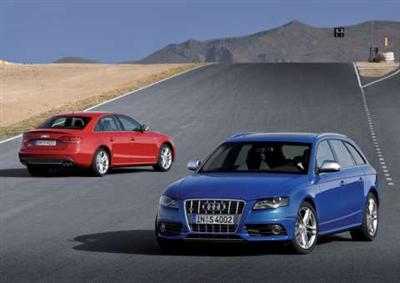|
| ||||
|
New Audi S4 For 2009
24th September, 2008 | |||
|
Audi is introducing its new sporty models in the mid-size class the S4 and the S4 Avant - at next month's Paris Motor Show. The engine, a three-litre V6 with direct fuel injection and mechanical turbo charging, delivers a powerful 245 kW. It accelerates the S4 sedan from 0 to 100 km/h in just 5.1 seconds, but on average only uses 9.7 litres of fuel per 100 km. The quattro permanent all-wheel drive system transfers its power to the road in style, which is then converted by the sport suspension into dynamic handling. Upon request, Audi can equip the new S4 and S4 Avant with innovative technologies that further increase their lead over the competition. The seven-speed S tronic changes gears with lightning speed and the new sport differential distributes the torque as needed between the rear wheels. The 'heart' of the new S4 and S4 Avant is a completely redesigned engine. The 3.0 TFSI, the newest member of the Audi V-engine 'family', is an outstanding example of how the brand with the four rings blends performance and efficiency. The V6 generates its power from a displacement of 2,995 cc, is equipped with a supercharger, and delivers 245 kW. It is electronically governed to a top speed of 250 km/h. The T in the 3.0s TFSI nomenclature no longer merely stands for turbo, but rather for the concept of supercharging in general extensive testing on the V6 has proven the superiority of mechanical charging. In conjunction with direct injection it is far superior to twin turbochargers, both in terms of packaging and of starting performance and responsiveness. The compressor is so compact that it easily fits inside the 90-degree V of the cylinder banks, in place of the intake manifold. Two four-vane rotary pistons counter-rotate inside the turbocharger at up to 23,000 rpm. Two charge-air coolers are integrated into the housing and are connected to a separate coolant circuit. An impressive array of measures keeps the noise generated by the compressor to a minimum. The engine-driven belt that powers the mechanical charger provides full thrust right from idling speed. The 3.0 TFSI delivers its maximum 440 Nm at 2,500 rpm and maintains this constantly until 4,850 rpm. In fourth gear, the vehicle accelerates from 80 to 120 km/h in just 4.4 seconds. Thanks to the extremely short gas paths, the sonorous, supercharged V6 responds spontaneously to the throttle, even more so than a naturally aspirated engine of the same displacement. Furthermore, the new 3.0 TFSI achieves exemplary fuel efficiency. On average, the sedan uses 9.7 litres of fuel per 100 km and the Avant 9.9 litres per 100 km an improvement of 3.4 litres (26 percent) compared with its predecessor. The Audi technology of petrol direct injection was what made this great efficiency possible in the first place. Unlike conventional concepts, it allows the compressor to be located behind the throttle valve. In view of the low density of the intake air at loads below supercharging level and when coasting, its rotors are free-running and the amount of power required to drive them is low. An Australian release date has not yet been announced. But, here at Next Car, the release date will be published once confirmation has been announced. | ||||
ABN 47106248033 |
 |
All rights reserved. |


